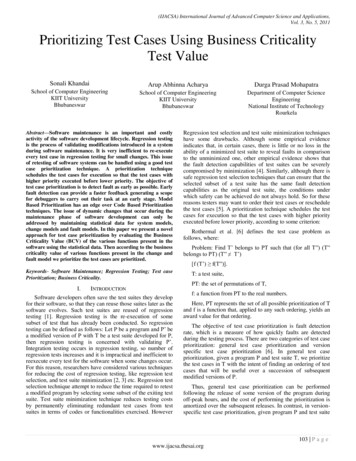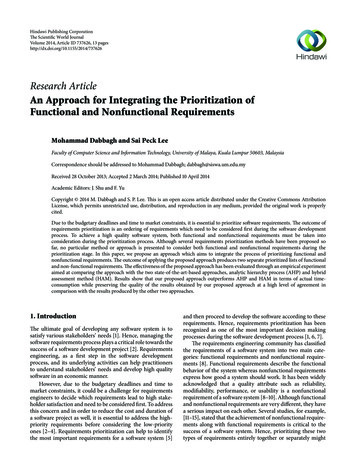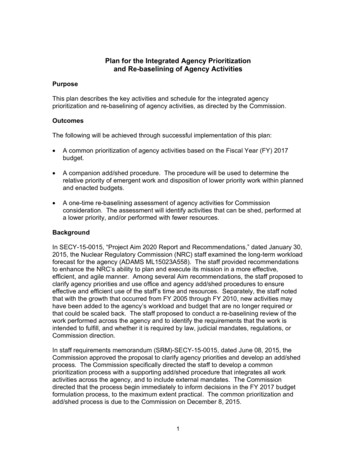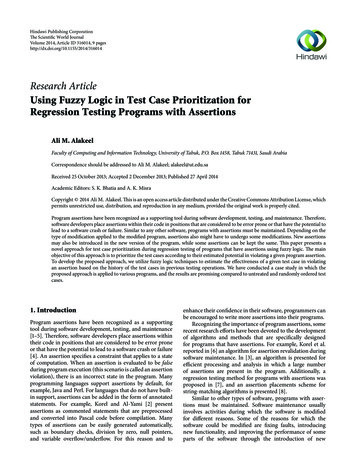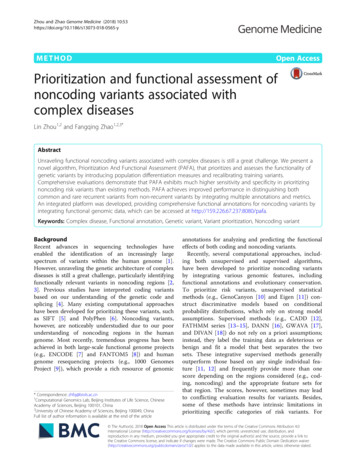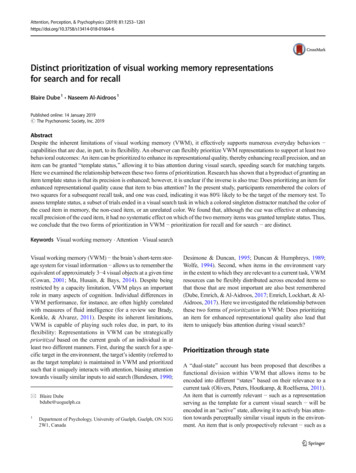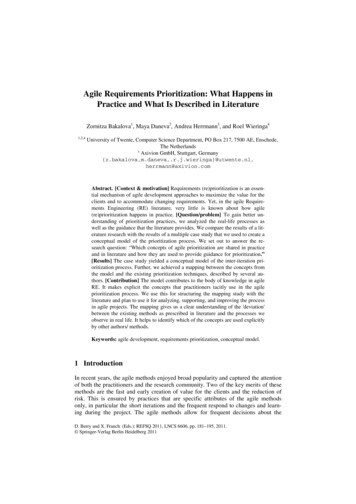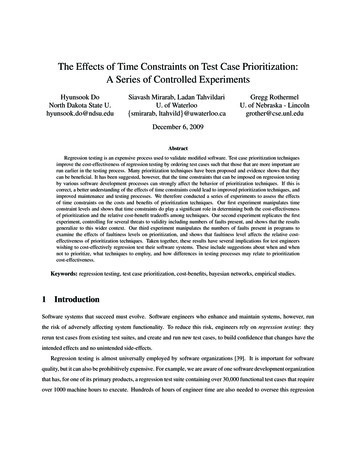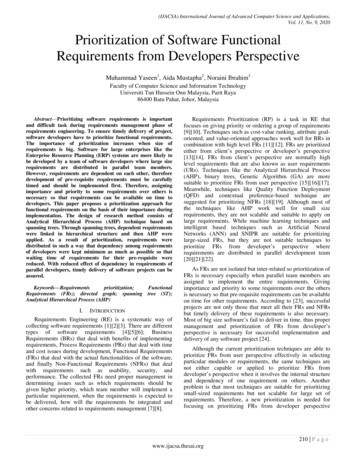
Transcription
(IJACSA) International Journal of Advanced Computer Science and Applications,Vol. 11, No. 9, 2020Prioritization of Software FunctionalRequirements from Developers PerspectiveMuhammad Yaseen1, Aida Mustapha2, Noraini Ibrahim3Faculty of Computer Science and Information TechnologyUniversiti Tun Hussein Onn Malaysia, Parit Raya86400 Batu Pahat, Johor, MalaysiaAbstract—Prioritizing software requirements is importantand difficult task during requirements management phase ofrequirements engineering. To ensure timely delivery of project,software developers have to prioritize functional requirements.The importance of prioritization increases when size ofrequirements is big. Software for large enterprises like theEnterprise Resource Planning (ERP) systems are more likely tobe developed by a team of software developers where large sizerequirements are distributed in parallel team members.However, requirements are dependent on each other, thereforedevelopment of pre-requisite requirements must be carefullytimed and should be implemented first. Therefore, assigningimportance and priority to some requirements over others isnecessary so that requirements can be available on time todevelopers. This paper proposes a prioritization approach forfunctional requirements on the basis of their importance duringimplementation. The design of research method consists ofAnalytical Hierarchical Process (AHP) technique based onspanning trees. Through spanning trees, dependent requirementswere linked in hierarchical structure and then AHP wereapplied. As a result of prioritization, requirements weredistributed in such a way that dependency among requirementsof developers were kept minimum as much as possible so thatwaiting time of requirements for their pre-requisite werereduced. With reduced effect of dependency in requirements ofparallel developers, timely delivery of software projects can nctionalRequirements (FRs); directed graph; spanning tree (ST);Analytical Hierarchical Process (AHP)I.INTRODUCTIONRequirements Engineering (RE) is a systematic way ofcollecting software requirements [1][2][3]. There are differenttypes of software requirements [4][5][6]; BusinessRequirements (BRs) that deal with benefits of implementingrequirements, Process Requirements (PRs) that deal with timeand cost issues during development, Functional Requirements(FRs) that deal with the actual functionalities of the software,and finally Non-Functional Requirements (NFRs) that dealwith requirements such as usability, security, andperformance. The collected FRs need proper management indetermining issues such as which requirements should begiven higher priority, which team member will implement aparticular requirement, when the requirements is expected tobe delivered, how will the requirements be integrated andother concerns related to requirements management [7][8].Requirements Prioritization (RP) is a task in RE thatfocuses on giving priority or ordering a group of requirements[9][10]. Techniques such as cost-value ranking, attribute goaloriented, and value-oriented approaches work well for BRs incombination with high level FRs [11][12]. FRs are prioritizedeither from client‘s perspective or developer‘s perspective[13][14]. FRs from client‘s perspective are normally highlevel requirements that are also known as user requirements(URs). Techniques like the Analytical Hierarchical Process(AHP), binary trees, Genetic Algorithm (GA) are moresuitable to prioritize FRs from user perspective [15][16][17].Meanwhile, techniques like Quality Function Deployment(QFD) and contextual preference-based technique aresuggested for prioritizing NFRs [18][19]. Although most ofthe techniques like AHP work well for small sizerequirements, they are not scalable and suitable to apply onlarge requirements. While machine learning techniques andintelligent based techniques such as Artificial NeuralNetworks (ANN) and SNIPR are suitable for prioritizinglarge-sized FRs, but they are not suitable techniques toprioritize FRs from developer‘s perspective whererequirements are distributed in parallel development team[20][21][22].As FRs are not isolated but inter-related so prioritization ofFRs is necessary especially when parallel team members areassigned to implement the entire requirements. Givingimportance and priority to some requirements over the othersis necessary so that pre-requisite requirements can be availableon time for other requirements. According to [23], successfulprojects are not only those that meet all their FRs and NFRsbut timely delivery of these requirements is also necessary.Most of big size software‘s fail to deliver in time, thus propermanagement and prioritization of FRs from developer‘sperspective is necessary for successful implementation anddelivery of any software project [24].Although the current prioritization techniques are able toprioritize FRs from user perspective effectively in selectingparticular modules or requirements, the same techniques arenot either capable or applied to prioritize FRs fromdeveloper‘s perspective when it involves the internal structureand dependency of one requirement on others. Anotherproblem is that most techniques are suitable for prioritizingsmall-sized requirements but not scalable for large set ofrequirements. Therefore, a new prioritization is needed forfocusing on prioritizing FRs from developer perspective210 P a g ewww.ijacsa.thesai.org
(IJACSA) International Journal of Advanced Computer Science and Applications,Vol. 11, No. 9, 2020within the setting of large size requirements especially inparallel developing projects.Technique like AHP can be applied with pre-definedprioritization rules to FRs but it is not scalable for big-sizedrequirements. However, we can use technique such as AHPthat pairwise compare requirements to prioritize requirementsfrom developer‘s perspective.To address this gap, this research work proposes a newapproach to prioritize FRs using AHP but based on spanningtrees, called the SAHP. The proposed prioritization approachwill then be evaluated on FRs of ODOO ERP as case study.Finally, this paper will also investigate the scalability ofSAHP in ERP systems by comparing time complexity of theSAHP with existing AHP. The remaining of this paperproceeds as follows. Section 2 presents preliminary studiesrelated to AHP. Section 3 presents the proposed AHP basedon Spanning Trees called the SAHP. Section 4 reportsevaluation of prioritization experiments using requirements ofERP system. Section 5 presents efficient distribution ofrequirements in parallel team members and finally Section 6concludes with some indication for future work.II. BACKGROUND STUDYAnalytical Hierarchical Process (AHP) is an organizeddecision-making method that is intended to compute complexmulti-criteria decision problems. AHP is technique that is alsoapplied efficiently in many other fields such as biology andsocial sciences for prioritization. In fact, AHP is the utmostfrequently discussed prioritization technique within decisionmaking in requirements engineering. AHP is led by comparingall possible pairs of hierarchically categorized entities such asrequirements as well as stakeholders for obtainingcomparative priorities for all objects [15].Research in [25] revealed that AHP is capable ofimproving total time of calculations for pairwise comparisonsof the requirements by using eigenvalues and matrixevaluation. The research also proposed Consistency Index (CI)to remove errors like inconsistency. Basically therequirements are arranged in groups called bins in the form ofhierarchy. This form of prioritization although be helpful inthose cases where requirements are not too much and we needto prioritize with the help of AHP. Number of comparisonswill be less as compared to traditional AHP but still it failslarge set of requirements.According to [26], although we assign priorities to FRs,we can also assign priorities on the basis of PRs. The workdiscussed prioritization of PRs by considering both localpriority and perspective priority and proposed the CorrelationBased Priority Assessment (CBPA) that prioritizesrequirements from different stakeholder perspectives while tohighlight the key issues among them. Two types ofrequirements were considered (1) from business point of viewand (2) from management point of view. Increased profit, leadin competition, reduced cost of development, reduced time todevelopment are business-oriented process requirements whilemaintaining a project within budget, on schedule, highcustomer satisfaction, increase productivity are managementoriented process requirements that are considered andprioritized in the research work by author. The relationshipbetween different requirements, its prioritization and impactare discussed in the paper in the form of matrix. Apart fromPRs, prioritization of requirements from multiplestakeholder‘s point of view is also discussed. High priorityrequirement needs more attention and leads to project success[26].Apart from fully AHP-based solutions to prioritization ofrequirements, intelligent-based solution has also beenproposed for prioritization of requirements collected fromstakeholders by applying machine learning techniques to firstgroup similar requirements, and then apply Artificial NeuralNetworks (ANN) for further prioritization. Finally, AHP wasapplied at the end for final comparisons. In first step, beforeclustering, stakeholders are requested to prepare requirements,then on the basis of profiles of stakeholders and throughexpert opinions using ANN, requirements can be prioritized[22].Along with stakeholder preferences, it is also necessary tohave prioritization which can handle dependencies in betweenrequirements from user perspective. DRANK is an automatedalgorithm was presented to perform comparisons based on theimportance of dependent requirements and compared theresults with AHP and other techniques. Experiments provedthat this technique is more efficient and scalable for large sizeURs [27].Though many authors have used AHP and tried to reducenumber of comparisons from different perspectives, AHP arestill unable to cater prioritization of FRs during an activeimplementation software life cycle. Existing AHPimplementation needs user input for pairwise comparison ofrequirements, while we need this process to be automatic i.e.to take input from its internal structure rather than user. Thepurpose of this study is to reduce this research gap to prioritizeFRs from developer‘s perspective.III. PROPOSED AHP BASED ON SPANNING TREE (SAHP)This section proposes spanning trees based approach torepresent FRs and then prioritized with AHP. Spanning treerepresents hierarchal order and dependencies of all interrelated requirements. From spanning tree, one can easilypairwise compare requirements with AHP. FRs collected fromany sources using appropriate elicitation technique and mustbe specified in the form of Software RequirementSpecification (SRS). In this research, the FRs are representedas alphabets R1, R2, , Rn and are enclosed in circles asnodes.A. Spanning TreesIn graph theory, a spanning tree is a subset of graph. Agraph G (V; E) consists of finite set of vertices V and finiteset of edges E. Edge is something that connects two vertices.Graphs are useful for the representation of any kind of data inparticular sequence [28][29]. This research uses directedacyclic graphs (DAG) rather than cyclic graphs. Requirementsare represented as vertices and arrows in the graph indicatesthe dependency of a requirement on another requirement. Therequirement generates arrow and points to anotherrequirement indicating that it is necessary or required for211 P a g ewww.ijacsa.thesai.org
(IJACSA) International Journal of Advanced Computer Science and Applications,Vol. 11, No. 9, 2020another requirement. For example, R1 R2 indicates that R1is depended on R2 or R2 is required for the completion of R1.Given the requirements collected, Fig. 1 shows the graphicalrepresentation of requirements through DAG. Cycles inrequirements are not possible because if one requirement isneeded for the implementation of other requirement thanopposite is not possible e.g. if R1 is required for R2 and R2 isrequired for R3 than it is not possible that R3 will be requiredfor R2 and R1. Graph based approach is also used in one ofour previous research study to related FRs [30].Spanning trees are special graph that have severalimportant properties. First, if T is a spanning tree of graph G,then T must span G, meaning T must contain every vertex inG. Second, T must be a sub graph of G. In other words, everyedge that is in T must also appear in G. Third, if every edge inT also exists in G, then G is identical to T [31]. Spanning treescan be formed simply either by performing breadth-firstsearch (BFS) or depth-first search (DFS) or it can be formeddirectly from adjacency matrix. Because spanning trees usegraph-based search algorithms that are only dependent on thenumber of vertices in the graph, the algorithms areconsiderably fast [32][33]. The general properties of spanningtrees are as follows.The resulting spanning trees from graph of Fig. 1 areshown in Fig. 2. From a spanning tree, one can easily see theneed of particular requirement in relation to 2Fig. 1. Graph Connecting Requirements for Making Spanning Tree from Fig. 2. Tree 1, Tree 2, Tree 3, Tree 4, Respectively.212 P a g ewww.ijacsa.thesai.org
(IJACSA) International Journal of Advanced Computer Science and Applications,Vol. 11, No. 9, 2020B. Analytical Hierarchical Process (AHP)Spanning trees will show the relationship of requirementwith other requirements. As shown in Fig. 2, a finite numberof spanning trees will be produced from directed graph. Next,AHP will be applied to individual trees or combination ofmany trees that have common requirements. The main idea isthat while applying AHP to spanning tree, only dependedrequirements will be compared, hence resulting in optimalprioritization in a reduced time. For example, consider thespanning tree with starting node R6 shown in Fig. 2, R6 willbe compared with R3, R1 and R7 as it is required for all theserequirements. However, R7 will be not compared with R1 orR3 as there is no direct relation with these requirements. Inthis case, when R6 is compared with R3 or any otherrequirement, then there is no need to compare between R3with R6. Requirements that are not depended can beconsidered as equal during comparison and assigned withvalue 1. This means with the help of spanning tree, thenumber of comparisons can be greatly reduced. AHP can beapplied to either every spanning tree individually orcombination of two or more trees if they have somerequirements in common. We have five spanning trees asgiven in Fig. 2. AHP will be applied to first four spanningtrees combined as they are related by some commonrequirements. First, apply AHP to Tree 5 starting with root R8and then apply AHP to combined four trees. Table I showsrequirements of Tree 5 for comparison and calculation.From Table I, we can see that we can put value either 1 orgreater than 1 while comparing any two requirements. We canTABLE I.only put 1 or greater value where 1 represents equal priorityrequirements and value greater than 1 represents thoserequirements that have not equal priorities. For instance, wecan use values such as 2, 3, 4, , n for requirements that arenot equal in priorities. If we increase the value, the differencein both requirements will be increased. The value 2 is takenfor requirement that is needed for other requirement. Forinstance, if R1 is required for R2 and R2 is required for R3,then we will put 2 for R1 against R2 and will put 4 for R1against R3. The value 1 is taken for requirements that haveeither equal priority or not related and 2 against thoserequirements that need this particular requirement as well andvalue ½ for the reverse case. In this case, as R8 is required forR9, therefore the value is 2 against R9 for R8. Priority valuefor each requirement against other requirements is shown inTable I e.g. priority of R9 against R8 is 0.5 which meanspriority of R8 is double as compare to R9. For independentrequirements like R10 and R12, we put value 1 because theserequirements have no relation.Next, the task is to calculate normalized values for eachrequirement by dividing the values of each column value inTable I by column sum. Column sum for each column isshown in Table II. For example, the value 1 in the first rowand the first column will be divided by 2.5, which comes to0.4. Consequently, normalized values for each requirement areshown in Table II. The column sum2 represents the averagingover normalized values for each row. The same process is thenrepeated for the combined four trees together and the valuesobtained in shown in Table III.PAIRWISE COMPARISON FOR TREE 00010.00011.00018.00018.000TABLE II.NORMALIZATION AND AVERAGING AND FOR TREE 5R8R9R10R11R12R13R14Sum2/priorityOut of 1(x sum/7)Z .0550.0550.4400.0600.030213 P a g ewww.ijacsa.thesai.org
(IJACSA) International Journal of Advanced Computer Science and Applications,Vol. 11, No. 9, 2020TABLE III.CALCULATING PRIORITIES OF TREE 1 TO TREE 4 (COMBINED)R1R2R3R4R5R6R7Sum2/priorityOut of 1(y sum/7)Z .1250.8640.1230.062The column sum2 also shows the priority value of everyrequirement of the spanning tree, in particular, or combinationof spanning trees. The sum of these sum2 values will equal tonumber of requirements i.e. 7. These values can be divided onnumber of requirements to find priority of requirements out of1. For considering whole set of requirements i.e. In 14requirements, priority value will be divided on 2 (2 is sumvalue for all requirements priorities). Column value z forTable II and Table III shows priority out of 14 requirements.Priority out of 14 is calculated. Similarly, for calculatingpriority of requirement in 100, value 100 is multiplied.C. Time Complexity of SAHPTime complexity of AHP depends on total number ofpairwise comparisons. With spanning tree, total number ofcomparisons are reduced because of limited number ofrelations. Either we consider combination of all spanning treesin one table or individual trees, the number of comparisons ofdependent or related requirements will be always same (fromadjacency matrix one can see how much relations exists). Thenumber of comparisons in all cases will depend on how muchrelations of requirements in graph exist. In this example, asonly 20 relations are possible, the total number of comparisonswill equal to only 20. Therefore, in this way, number ofnecessary comparisons are reduced from n*(n-1) / 2, whichwas from 91 to only 20 in this example. This reduction invalue shows the advantage of using spanning trees for relateddepended requirements only. Overall values and calculationsduring comparing requirements can be reduced by consideringindividual trees for prioritization as explained.For given requirements set, maximum relations that canexists are equal to ((n-1) (n-2) (n-3) . . . (n-n)), wheren are total number of requirements. This is possible when allrequirements are connected point to point in chain likestructure such that one requirement is dependent on otherrequirement. The value of n will be decremented and will beadded until it reaches to 0. In such case, total number ofcomparisons will become n*(n-1) / 2 which is equal to numberof comparisons of AHP. The minimum number of relationswill be 0 in any requirements set. In such case, priority of allrequirements will be consider to be equal i.e. 1. Fig. 3 showsnumber of comparisons of two techniques i.e. AHP withoutspanning trees by considering all requirements and AHP withspanning trees. Let‘s take 10 requirements. Minimum possiblerelations are 0 while maximum relations can be 45. Anynumber of relations can be possible between 0 and 45. Theorange linear line of Fig. 3 shows that number of comparisonsin this proposed approach is directly proportional to number ofrelations. It is equal to 45 i.e. case of AHP where maximumrelations exist. In small set of requirements whererequirements are few in amount, this is possible that maximumrelations exist (number of relations reaches number ofrequirements) such that each requirement is point to pointconnected with other requirement but we rarely can see suchnumber of relations in large set of requirements like ERP.From this discussion, it can be concluded that bycomparing only the depended requirements through spanningtree, the number of comparisons and calculations can begreatly reduced. Therefore, although total comparisons ofdependent requirements are same in all cases, but as the entireproject, the number of comparisons and calculated normalizedvalues are not same due to independent requirements.D. Requirements PriorityPriority is assigned to requirements on the basis of itsposition in spanning tree i.e. how much they are needed anddependent on other requirements. Requirements need caneither increase breadth-wise or depth-wise. In either case,priority can increase but priority values in both cases can bedifferent. Similarly, priority of requirement can decrease whenrequirements are dependent and wait for other requirements.AHP can be applied for calculating priority of requirementon the basis of how much they are depended or required forother requirements. AHP is simple and accurate prioritizingtechnique that can find priority of requirements by comparingpairwise all requirements together. If requirement let say R1 isrequired for R2 and R2 is required for R3, then priority of R1can be taken as double of R2 or it can be said that priority ofR1 is two times as compared to R2 while R1 priority is 4times as compare to R3. The following scenarios showdifferent cases of requirements behavior as they change whenapplied with AHP.Scenario 1: In this scenario priority of requirement isdetermined when its need for other requirements increasesbreadthwise. Breadthwise contain all requirements on samelevel with same priority. Two cases can be considered here,one with seven requirements and other with five requirementsand calculate priorities.Case 1: In this case, R1 is required for six otherrequirements with all requirements on same level with samepriority as shown in Fig. 4.214 P a g ewww.ijacsa.thesai.org
(IJACSA) International Journal of Advanced Computer Science and Applications,Vol. 11, No. 9, 2020Through AHP, we have calculated priority of R1 bycomparing all seven requirements together which is equal to1.75. R1 is considered to be double in priority as compare toindividual requirements during pairwise comparison. Thepriority of all other requirements is shown in Table IV.Table IV summarizes priority values for all requirements.other requirements in depth wise structure such that onerequirement is depended on other requirement as shown inFig. 5. In case 02, number of requirements that need R1 arereduced from six to four. Priority of R1 in first case comes out3.5 while in second case it is 2.21. The priority of R1 in 2ndcase of scenario 2 (required for four requirements) is stillgreater than case 01 of scenario 1 (required for sixrequirements). This shows priority increases with greater ratiodepth wise and this has advantage because in scenario 1, R1 isavailable to all requirements after implementation but inscenario 2, it is not available to all requirements e.g. R7 inscenario 2 can‘t be implemented when R6 is not available butin scenario 1, all requirements are dependent on R1.Case 2: In this case, R1 is required for four otherrequirements with all requirements on same level or priority inFig. 4. Now priority of R1 is reduced to 1.32 as shown inTable IV.Scenario 2: In this scenario, requirements size increasesdepth wise. In case 01 of scenario 1, R1 is required for sixFig. 3. Comparison of AHP and Proposed Approach.R1R1R3R2R5R4R6R7R2R5R4R3Fig. 4. Breadth-Wise Increase of Requirements.TABLE IV.COMPARISON OF PRIORITY OF REQUIREMENTS AS RESULT OF AHPScenario 1Scenario 2RequirementsScenario 3Case 1Case 2Case 1Case 0.5000.9002.0R1R2R1R3R2R4R5R33R4R7R6R5Fig. 5. Depth-Wise Increase of Requirements.215 P a g ewww.ijacsa.thesai.org
(IJACSA) International Journal of Advanced Computer Science and Applications,Vol. 11, No. 9, 2020Scenario 3: Priority of requirement decreases when itsdependency on other requirements increase. The reason is thatduring comparison against other requirements, sum of valuesare reciprocal of 1. Fig. 6 shows the priority of R1 against R6and R7 will be equal to ½. The sum of reciprocal values willreduce the priority of requirement. Priority of R1 is now 1,which is minimum as compared to all cases. Priority of otherrequirements are shown in Table IV.From values given in above Table IV, it can be concludedthat requirement priority is associated with its increasing sizebut the ratio in which it increases depth wise is greater thanbreadth wise and it should be increase with high ratio in depthwise as compare to breadthwise because in breadthwise, thepre-requisite requirement is available for all requirements andthe delay is not too much as compare to the case of depth wisewhere pre-requisite requirement is not available for allrequirements and by delaying this requirement can delay theimplementation of its requirements more in case of paralleldeveloping project.Similarly, if number of pre-requisite requirements andnumber of requirements for which particular requirement isneeded are equal then priority of requirement will be equal.For example, in Fig. 7, the number of backward and forwardrequirements for R1 are equal, in all cases priority ofrequirement will be equal. With AHP, we have calculatedpriority of R1 that is 0.84 for all cases of Fig. 7.R7R6R1R2R4R3R5Fig. 6. Number of Pre-Requisite Connected with Requirement.R2R1R3R3R2R2R1R6R3R1R5R4R4R7R5Fig. 7. Distribution of Requirements with Same Ratio.IV. VALIDATION OF SAHP ON ODOO ERPSAHP was evaluated on requirements of On DemandOpen Object (ODOO). ODOO is open source ERP softwaresystem that is used by millions of users for managinghundreds of possible enterprises and their resources. In manyof research studies, authors used different modules of ODOOERP [34][35][36]. In ERP system, all modules are integratedwhich shows that all the requirements should be inter-related.Modules of ERP are highest level URs that are furthercomprised of low level FRs. With spanning tree, we can relateFRs that can belong to any module. Module is just high levelabstraction to which requirements of same nature belong e.g.customer and supplier creation are FRs that belong to HRmodule while customer sale and supplier sale are FRs thatbelong to sale management module. With spanning tree, wecan relate these FRs that belong to different modules. Thusspanning tree does not show abstraction or high levelrepresentation of requirements because it relates only differentrequirements that belong to particular module. Selection ofparticular modules have impact on priority of their FRs. Thismeans variations in selecting different modules by users haveimpact on FRs structure. The suggested prioritizationapproach will be applied on the FRs of ODOO to prioritizethem. The modules of ERP consists of 96 FRs for this study asshown in Table V.216 P a g ewww.ijacsa.thesai.org
(IJACSA) International Journal of Advanced Computer Science and Applications,Vol. 11, No. 9, 2020TABLE V.NotationRequirementModuleNo.R1employee creation1R2publicinformation‘s ofemployee1R3employee personalinfo1R4contact info1R5job position1R6department1R7job formation‘scontract referenceinformation‘sREQUIREMENTS OF ODOO ERP FOR HR MODULERequiredForR81, R25,R23, R67,R2, R4, R10,R11, R12,R17, R18,R20, R21,R22, R7, R9,R8R5, R61, R67TreeNotationRequirementModuleNo.T1R69sale return view3T1R42purchase4R59purchase view4T4R60purchase return4T2, T3R68purchase returnview4T2, T3R5, R24, R67RequiredForTreeT10R51, R59T4, T5,T6T4, T5,T6T4R68T4R42, R60,R66, R35,R70, R71,R90,R34product5R66stock ledgers5R70product transfer in5T4R71product transfer R12salary generation1R21T1,T18R24project management6R22hr expenses1R23T1R25add team members6T1R23hr expenses detail1T1R26extra information‘s6T3T10R27project stages6T3R28view current task6R29create a task6R73, R55,R36, R35,R61, R64,R39R58,R63,R35R44, R65,R72, R42,R52, R60R26, R27,R28, R29T3R33customer detail1R37sales persons1R41supplier detail1R43sales man1R42,R44T5R30extra information‘s6R57region1R58R8R31tasks stages6R58area1R35R7, R8R93directories fordocuments7R80job position inrecruitment1T4R94documents history
between different requirements, its prioritization and impact are discussed in the paper in the form of matrix. Apart from PRs, prioritization of requirements from multiple stakeholder's point of view is also discussed. High priority requirement needs more attention and leads to project success [26].
